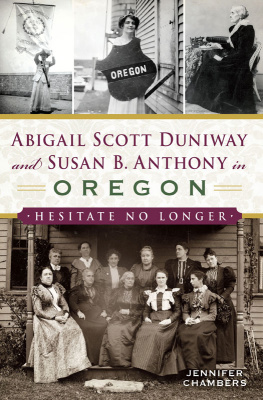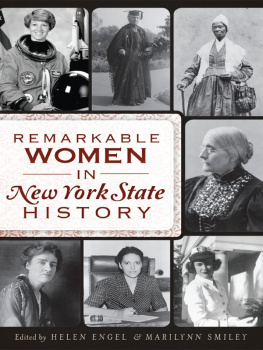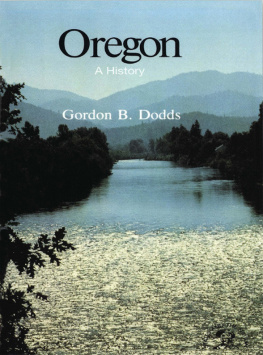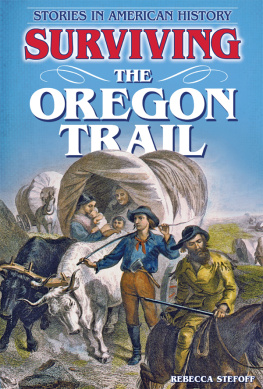
A map of Oregon from Colliers New Encyclopedia (1921). Wikimedia Commons.
This book is for my children, that they may know the accomplishments of these amazing women and be inspired to do their best in whatever is their passion. Changing the world can be as simple as changing your perspective if you work hard at it. Know that persistence pays off. Thanks for being with me when I work early in the morning, too.
As always, I am grateful for and amazed by the love and support of my husband, who makes my work possible.
Published by The History Press
Charleston, SC
www.historypress.net
Copyright 2015 by Jennifer Chambers
All rights reserved
First published 2015
e-book edition 2015
ISBN 978.1.62585.644.9
Library of Congress Control Number: 2015951456
print edition ISBN 978.1.46711.899.6
Notice: The information in this book is true and complete to the best of our knowledge. It is offered without guarantee on the part of the author or The History Press. The author and The History Press disclaim all liability in connection with the use of this book.
All rights reserved. No part of this book may be reproduced or transmitted in any form whatsoever without prior written permission from the publisher except in the case of brief quotations embodied in critical articles and reviews.
CONTENTS
ACKNOWLEDGEMENTS
I have had great assistance from the Oregon Historical Society, especially Elena Alvorado and Scott Rook; thank you for your time and work in assisting me with the fine photographs herein.
Thanks to Rhonda Chambers for the use of her photo of Opal Whiteleys mural.
Pat Edwards is a partner in business and a great person to have on your side. Thanks, Pat.
Nancy Parrish and Jana Churchwell, many thanks for your assistance with Hazel Lee. Your work was very helpful, and Im grateful for it. The help of Caroline D. Wilson from the Pentagon in researching Hazel Lee was also invaluable (and what fun to get e-mails from the actual Department of Defense!).
Thanks to Katie Meakins for her service and for the inspiration to find out more about Hazel Lee.
Thanks to my commissioning editor, Christen Thompson, for her help and support and to everyone at The History Press.
INTRODUCTION
I wanted to write about these women because Oregon has had so many women worth remembering. We are supposed to learn from history so we do not repeat its mistakes, true, but part of researching the influential people of the past is learning about the way they have created social and political change and changed the way we relate to the human condition. There is a quote by Ralph Waldo Emerson that puts it well:
Man is a bundle of relations, a knot of roots,
whose flower and fruitage is the world.
Another quote I kept in mind was by Opal Whiteley, who is featured in this book. She wrote about simple pleasures that get to the heart of what it is to be alive. Her work, though child-like, is beautiful. Id like to think that each of these women had cause to feel a similar way about something that was dear to them at some point in their lives: By the wood-shed is a brook. It goes singing on. Its joy-song does sing in my heart.
These women faced opposition from their society, from their families, from the world. They faced it by virtue of their sex sometimes or by political oppression or through poverty. The fact that so many of them were successful and managed to create things that lasted beyond their sphere really is remarkable.
Ive had a lot of joy myself living with these women as I researched them. My goal was twofold: to celebrate their accomplishments and to present those in as unbiased a way as I could so that the reader can draw her own inferences and perhaps take part of them into her own life. Learning more about and trying to represent even a portion of the women who influence Oregon as it is today has made me more aware of my own privilege. Its important to recognize how hard the women who came before me worked to make things better for all people. It has heightened the importance to teach my own children the idea that they, too, can question the status quo and propose change.
These are brief sketches of the women and are compiled to the best of my ability from a variety of reputable sources. I encourage the reader to follow up on any that interest you, as some of the subjects have longer, full-length works written about them, especially Julia Ruutilia (Sticking to the Union by Sandy Polishuk) and Beatrice Morrow Cannady (A Force for Change: Beatrice Morrow Cannady and the Struggle for Civil Rights in Oregon by Kimberly Mangun).
Remarkable women have made their mark on Oregon. They were not all born in Oregon, but they have impacted life here to such a degree that they have a place in our history. It makes sense that many of these women are not from the state originally, as Oregon, like the rest of the West, is an emigrant place, somewhere that is a destination rather than an origination point. More so, they are valuable to recall in times of struggle.
Enjoy their stories. Take them with you and see how you can impact your world.
Chapter 1
NATIVE WOMEN, FIRST WOMEN
MARIE DORION AND SARAH WINNEMUCCA
These Indian baskets along the wall here are old. That is an old Indian cooking basket; it would hold water if it were soaked up. See the little designs on it, they all mean something, but I dont know what. The beads in this basket are some my father secured after the big flood of the Willamette in 1861, when a lot of Indian graves were washed out. Some of these are Hudson Bay Company beads, the kind they traded to the Indians for furs, and some of themthe dark blue ones I thinkare beads said to have been used in trading by Lewis and Clark. The basket is full, you see, of many sorts of 2 necklets, etc., said to have been used at a very early day by various fur traders and early explorers. Father had them all labelled once, but they are all mixed up now. Someday, maybe, Ill find somebody who knows something about them and can straighten them out. Yes, its too bad to have their history lost.
Miss Mertie Stevens
It is an undeniable fact that the lives of Native Americans, or First Peoples, were inexorably changed when white settlers descended on and settled the West. Oregon was not unusual in its basic ignorance of native custom or ownership of land. The fact was the settlers entered a land inhabited by generations of people who were already there. Making a generalization about the women who lived in this area is difficult. All had their own beliefs, social systems and political and cultural customs. Females were, and remain, important and valued in the Native American culture of Oregon. Some, like Sarah Winnemucca and Marie Dorion, arent as well known as Sacagawea, but their contributions have been extremely important.
Oregon Territory was home to over eighty diverse groups of native tribes, as measured by Lewis and Clark on their first journey here in 1805 and 1806, with over thirty different languages. The Oregon Blue Book estimates that humans have been present in this area for at least 10,000 years, and perhaps for another 5,000 to 10,000 years before that. The distinct ecosystems of the Coast Range, with its lush, wet seascapes, remained largely unaffected by the Spanish occupation of California territory, as it was accessible mainly by sea. The tribes in the interior were influenced more when the horse was introduced a generation before. Most of the interaction with natives and Europeans was through the Columbia River region and the fur trade that centered in Astoria. In the middle of the 1800s, the dispersion of tribes via disease lessened and was replaced by removal to centrally located reservations. The makeup of tribal groups shifted, but the First People continue to have a great impact on the culture, environment and even physical locations in Oregon.









